In a nutshell: A white QR Code with a transparent background replaces the black foreground with white and removes the background, making it ideal for dark or branded surfaces. While visually appealing, it requires high contrast, proper sizing, and thorough testing to ensure scannability. The blog explains how to create and use these QR Codes effectively.
There is literally no place where one doesn’t find QR Codes – restaurant menus, business cards, and marketing campaigns.
Companies are getting innovative in how they can connect with their clients; this is why there is more interest in having a custom QR Code these days.
And, of course, one that gets all the attention at this time is the white QR Code. You’re probably wondering, “Can QR Codes be white?” Well Yes!
A. What is a custom white QR Code?
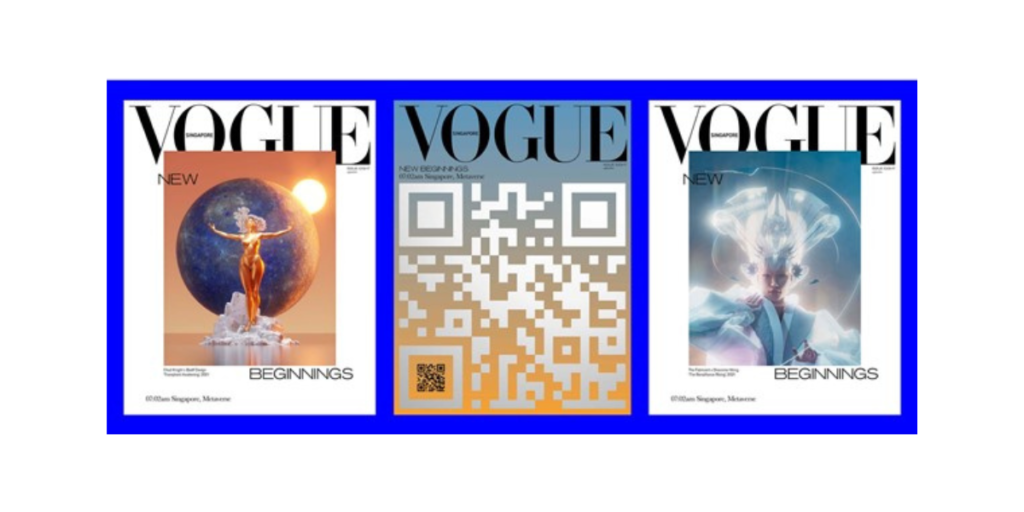
Custom white QR Codes refer to QR Codes that have been designed with a specific aesthetic in mind, typically featuring a white color scheme.
QR Codes are two-dimensional barcodes that can store a variety of information. These could include data such as text, URLs, and contact information.
Creating custom white QR Codes involves the customization of the QR Code’s appearance, primarily focusing on the color palette.
While a traditional QR Code is often black on a white background, a custom white QR Code inverts this color scheme and is a white QR code on a black background. The QR Code can be against any contrasting background as well.
There can even be a case where you have to create a white QR Code on a transparent background.
Curious? Let’s learn more about how to create a white QR Code using a white QR Code generator in detail.
B. How to create a customized white QR Code?

Step 1: Go to Scanova QR Code Generator
Step 2: Choose any relevant content category of your choice. For a demo, we’ll choose the “Website URL” option from the menu and input the desired URL. This will be the web address your QR Code directs to when scanned
Step 3: Make a selection between a “static” or “dynamic” QR Code. The default choice here is the dynamic option. Name your QR Code (eg. qr code white png) to remember it by.
Step 4: Initiate the QR Code generation process by clicking the “Generate QR Code” button. This action will produce a basic black-and-white QR Code linked to your website
Step 5: Now, you’ll see the “Edit Design” button under the QR Code on the right. Click on it. Here, you can choose a design template for your QR Code. You can either choose Recommended to see the suggested templates or use any previously saved template
Pro Tip: For custom white QR Codes, use dark or contrasting background colors to ensure good contrast. Light backgrounds can make it hard to scan, rendering your QR Code useless.
Step 6: Proceed further by clicking on the “Continue Editing” button. You’ll see various tabs to add a logo, change colors and shapes of eyes and data modules, and even change the background color
Step 7: To make a white QR Code, go to the Eyes tab and Data tab one by one and change the color to white (or use the color code #ffffff).
Now go to the Background tab and change the color to black (or use the color code #000000) or to any other contrasting colors. After all other design edits, move to the next step
Step 8: Before downloading and using the white QR Code, test it using different devices and QR Code scanning applications. This step ensures its proper operation and accurate redirection to the intended URL
Step 9: Get your white QR Code png by downloading it. Scanova provides the flexibility to download your QR Code in multiple formats that are suitable for both print and digital applications
Step 10: Now, you can add your white QR Code to your marketing materials and promotional content. Position it where it’s easily noticeable and can be conveniently scanned by your target audience

C. Is a white QR Code with a transparent background scannable?
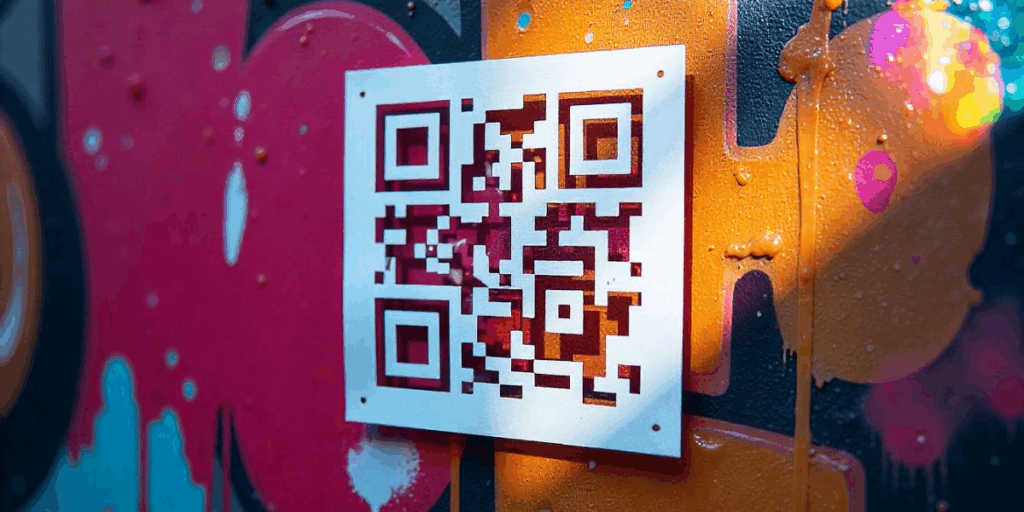
Yes, but only if it’s designed with technical precision. A white QR Code with a transparent background looks modern, but it also comes with limitations. Here’s what to watch out for and how to make it scannable:
1. Contrast is non-negotiable
QR Code scanners detect patterns by measuring contrast. To ensure readability, maintain a minimum contrast ratio of 4:1 between the QR Code and its background. A white QR Code on a pale or mid-tone background may fail to scan. For example, white on beige or grey rarely meets the contrast threshold.
2. Use flat, dark backgrounds
The best way to ensure scannability is to place the white QR Code on a solid black or dark navy background. Avoid gradients, shadows, or overlays. For instance, a black matte gift box with a white QR Code works well and looks premium.
3. Avoid cluttered or image-based surfaces
Transparent QR Codes over textured, patterned, or photo-heavy surfaces confuse scanners. A floral product label or a scenic background, even if dark, can interfere with the code’s readability. Stick to uniform, non-reflective surfaces.
4. Follow printing best practices
When printing white QR Codes, use high-resolution vector files (SVG or EPS) to avoid blurring. Print on matte or uncoated paper to reduce glare. Avoid transparent plastic or glossy finishes that may reflect light and block scanners. Minimum size should be at least 2 x 2 cm (0.8 inches) for printed materials.
5. Be aware of size and distance
Scanning apps require a minimum module size (the smallest black or white square) to decode the data. For white QR Codes, this is even more important. Ensure that the total code is large enough to be scanned from the intended distance. A QR Code on event signage should be at least 2 inches wide if viewed from a few feet away.
6. Test in different lighting and devices
White QR Codes are more sensitive to poor lighting, glare, and camera quality. Always test your QR Code in low light, direct light, and under shadows. Also, test on various smartphone models and apps to confirm universal scannability.
7. Never trade function for design
Custom QR Codes look great, but don’t compromise readability. Adding a logo, rounded edges, or reducing the quiet zone (the empty space around the QR Code) can lead to scan errors. The quiet zone should be at least 4 modules wide and completely transparent.
C. Why customize your white QR Code? Understanding the benefits

Customizing QR Codes offers several benefits, ranging from enhancing brand visibility to improving user engagement.
Here are some key reasons why individuals and businesses choose to customize QR Codes:
1. Brand integration
Customizing QR Codes allows businesses to integrate their brand colors, logos, and visual elements into the code.
This helps maintain a consistent brand identity across various marketing materials, making the QR Code an extension of the brand.
2. Aesthetic appeal
Standard black-on-white QR Codes can sometimes be visually stark or may clash with certain design aesthetics.
Customization enables designers to create QR Codes that blend seamlessly with the overall design of a product, advertisement, or packaging.
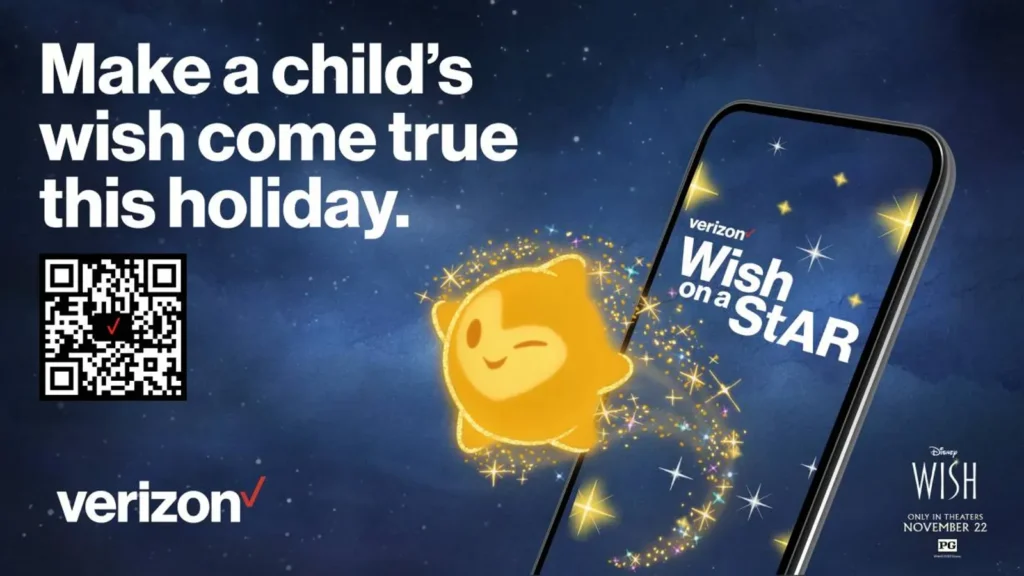
In November 2023, Disney teamed up with Verizon for a magical AR campaign called ‘Wish on a Star.’
The campaign used a white QR Code on a dark background that matched Disney’s branding and theme colors perfectly.
The QR Code in white color was not only visually appealing but also reflected Disney’s magical aesthetic, symbolizing stars in a night sky—perfectly aligned with the campaign’s celestial theme.
When people scanned the QR Code, they unlocked an AR experience showing a constellation of stars.
Each star symbolized a wish for children in need. Users could click on a star to make a donation, helping these children and spreading joy.
What we learned: The white QR Code was more than just functional—it blended beautifully with the campaign’s look, creating a seamless experience. This shows how well-designed QR Codes can enhance a brand’s message while engaging the audience meaningfully.
3. Increased visibility
Customized QR Codes can stand out more than standard black-and-white codes.
By using contrasting colors and incorporating design elements, businesses can increase the visibility of their QR Codes, making them more noticeable to consumers.
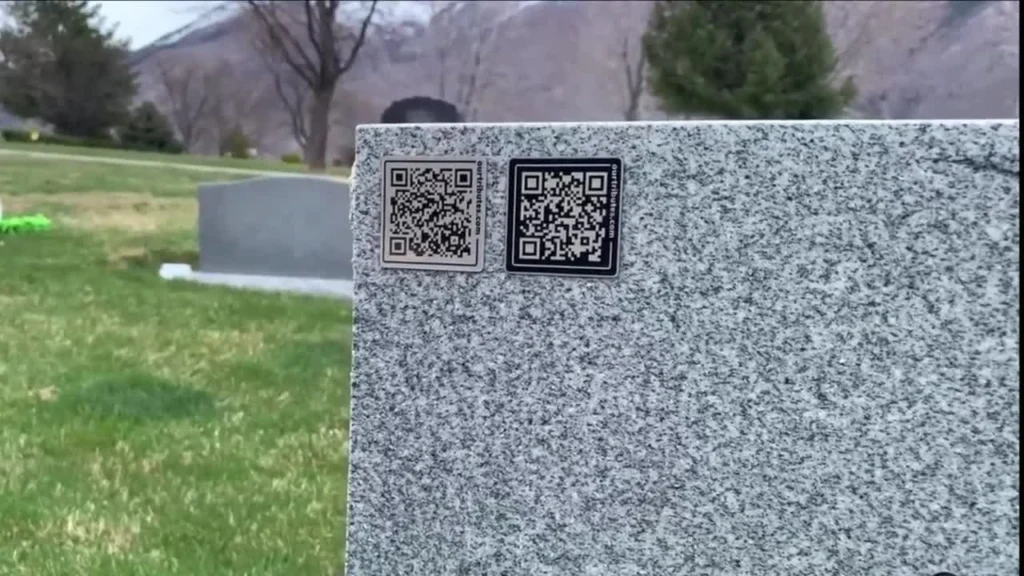
Remco Memorials Ltd. is the first funeral home in Canada to use white QR Codes on gravesites.
These QR Codes serve to preserve memories of the dead through photos, videos, and personal stories, wherein visitors can scan the code for more information about their lives.
They tested both black QR Codes on light-colored backgrounds and white QR Codes on dark-colored backgrounds.
What we learned: The white QR Code popped much more and was seen so much more often, significantly raising the number of scans. Such a simple aspect as contrast or color can influence the way in which one engages with an object.
4. Contextual relevance
Customization allows QR Codes to be more contextually relevant.
For example, a QR Code on a product packaging can be designed to complement the packaging’s visual theme or provide additional information about the product.
5. Promotional campaigns
When used in marketing and promotional materials, custom QR Codes can be tailored to match the theme of a campaign.
This adds a creative and personalized touch, potentially increasing the effectiveness of the campaign.
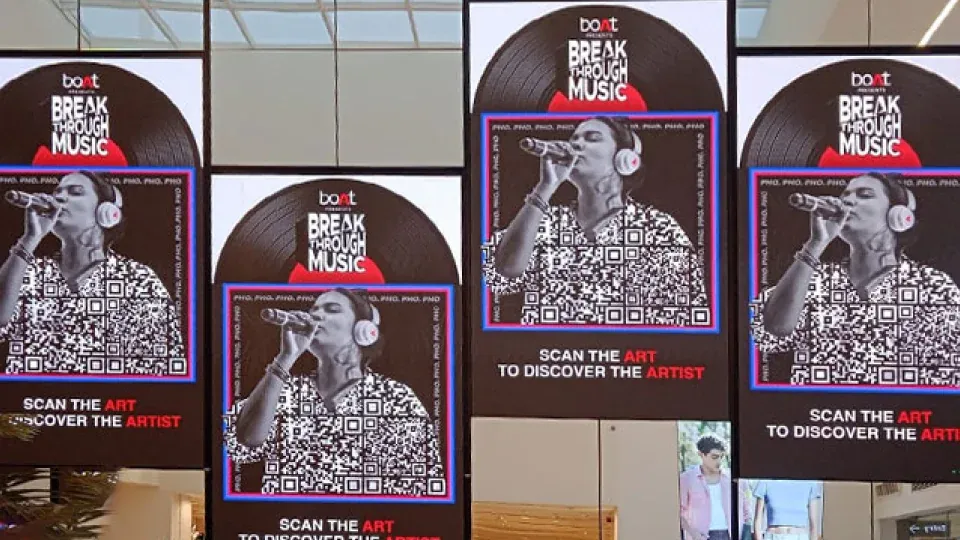
boAt Lifestyle, one of India’s leading audio brands, launched a campaign to spotlight emerging artists. These artists often struggle for visibility due to the ever-changing algorithms on streaming platforms.
To tackle this, boAt used QR Code-based art in YouTube ads and billboards. These white QR Codes on a dark background were scannable gateways to the artists’ profiles and music on platforms like Spotify and YouTube.
The QR Code directed users to boAt’s website, where they could discover more about the artist and their work. The white QR Code not only enhanced visibility but also added a touch of elegance to the campaign’s visuals.
What we learned: The contrast made it more noticeable and inviting for audiences to scan. This design aligned perfectly with the campaign’s modern and vibrant theme, boosting engagement.
6. Personalization
Custom QR Codes provide an opportunity for personalization. This can be particularly valuable in scenarios such as event invitations, where a QR Code can be designed to reflect the nature of the event or include personalized messages.
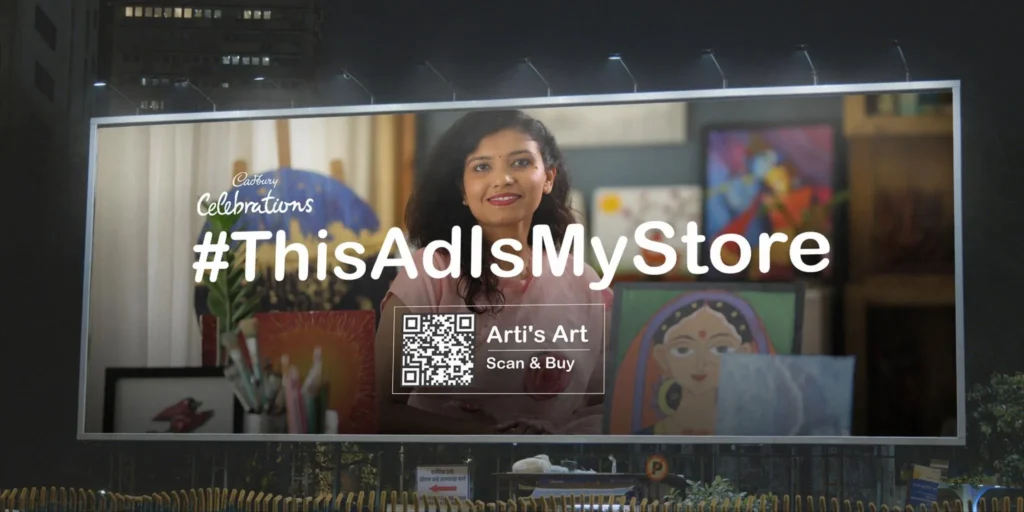
Cadbury Celebrations’ #ThisAdIsMyStore campaign used white QR Codes to help small business owners shine.
Every ad—whether on billboards, digital screens, or TV—featured local entrepreneurs and a white QR Code for better visibility and scannability.
Viewers scanned the QR Code, which took them directly to the entrepreneur’s WhatsApp for Business.
From there, they could browse products and make purchases. The use of white QR Codes ensured the QR stood out, even on busy backgrounds, which made it easy to scan and act.
What we learned: This innovative approach personalizes ads and directly connects small businesses with new customers, all while reinforcing Cadbury’s support for local communities.
7. Improved scannability
While customization is essential, it’s crucial to ensure that the QR Code remains easily scannable.
Design elements should not interfere with the code’s functionality, and there should be sufficient contrast for scanners to read the code accurately.
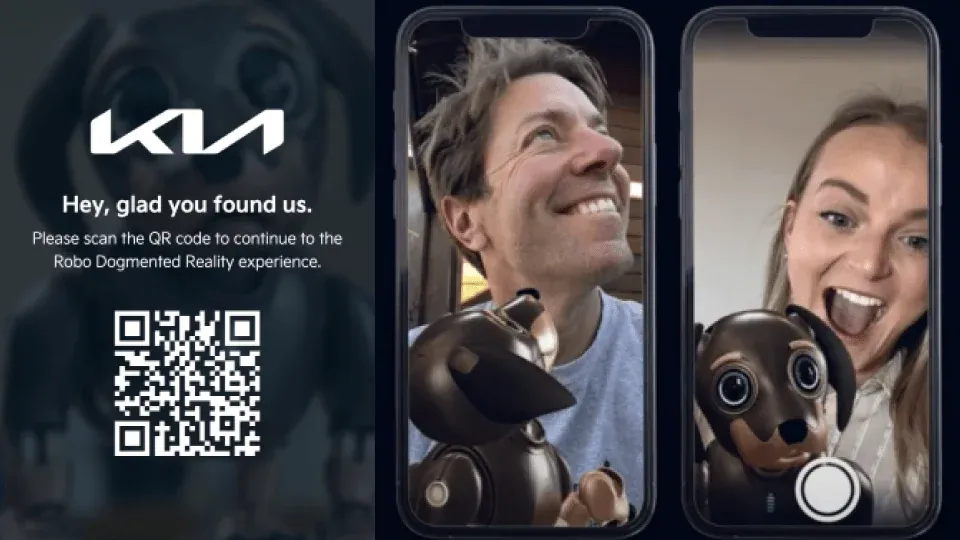
Kia’s “Accelerate The Good Program” helped raise awareness and support for shelter animals in need of loving homes.
As part of the initiative, Kia introduced “Robo Dogmented Reality”, an AR experience featuring an adorable robotic dog named Robo Dog. Using 8th Wall’s AR technology, this campaign brought Robo Dog right into people’s living rooms.
To make the experience seamless, Kia used white QR Codes on marketing materials like videos. The white QR Codes stood out on darker backgrounds, ensuring better visibility and higher scan rates.
Scanning the QR Code directed users to a website where they could explore the “dogmented reality” and connect with the campaign’s message.
What we learned: This shows how using white QR Codes can enhance engagement, especially in campaigns where capturing attention and driving scans is crucial.
8. Dynamic content updates
Dynamic QR Codes allow for the modification of the underlying content without changing the physical appearance of the code.
This flexibility is useful for campaigns where information may need to be updated regularly, such as changing a URL or promotional offer.
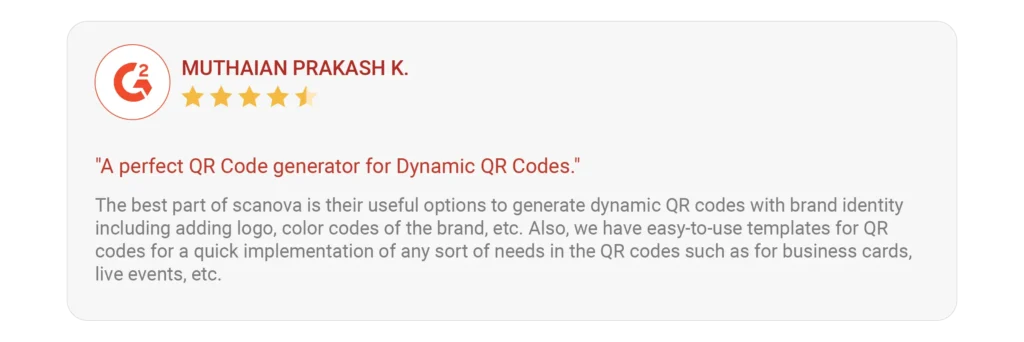
9. Analytics and tracking
Scanova offers analytics and tracking features for dynamic QR Codes.
This allows businesses to monitor the performance of their QR Code campaigns, including the number of scans, location data, and user engagement.

10. Competitive differentiation
A creatively customized QR Code can help a business or product stand out in a crowded market. It adds a unique and memorable aspect to the marketing strategy.
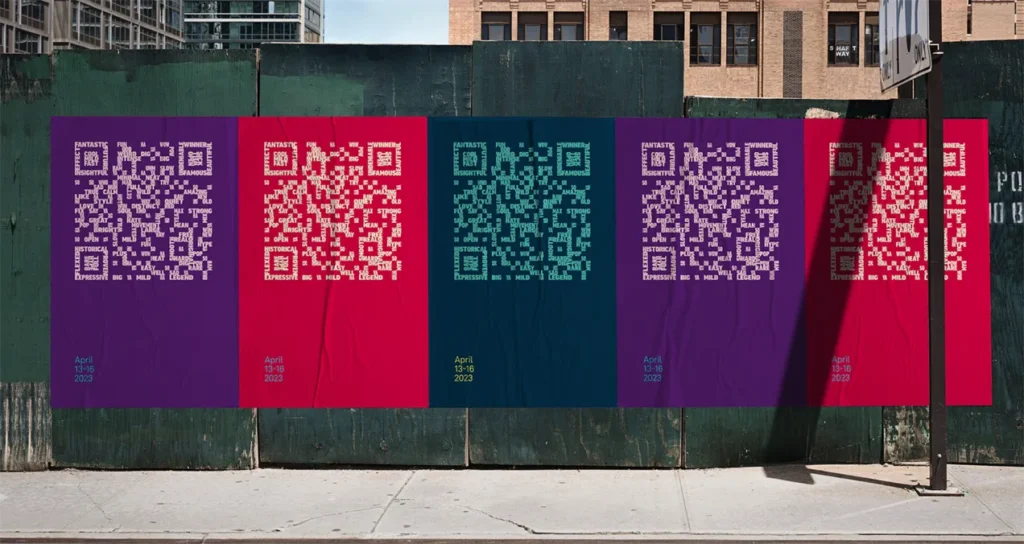
Informa Group and The Local Collective teamed up to create a unique marketing campaign for the Toronto Art Fair.
Instead of traditional art-focused visuals, they designed handcrafted QR Codes featuring words like “fantastic” and “expressive”—terms often used to describe art.
These QR Codes served both as functional links and as standalone art pieces, directing people to artist profiles, ticket purchases, and other initiatives.
To enhance visibility and draw attention, white QR Codes were used on contrasting dark backgrounds.
This ensured they stood out, improved scan rates, and added a touch of sophistication.
Unlike typical QR Codes placed as an afterthought, these codes were the centerpiece of the design.
What we learned: The campaign saw exceptional engagement, with more people interacting with posters and ads than expected. The standout design of white QR Codes enhanced scannability and created a striking brand identity, making the event as memorable as the art itself.
D. Design tips for custom white QR Codes
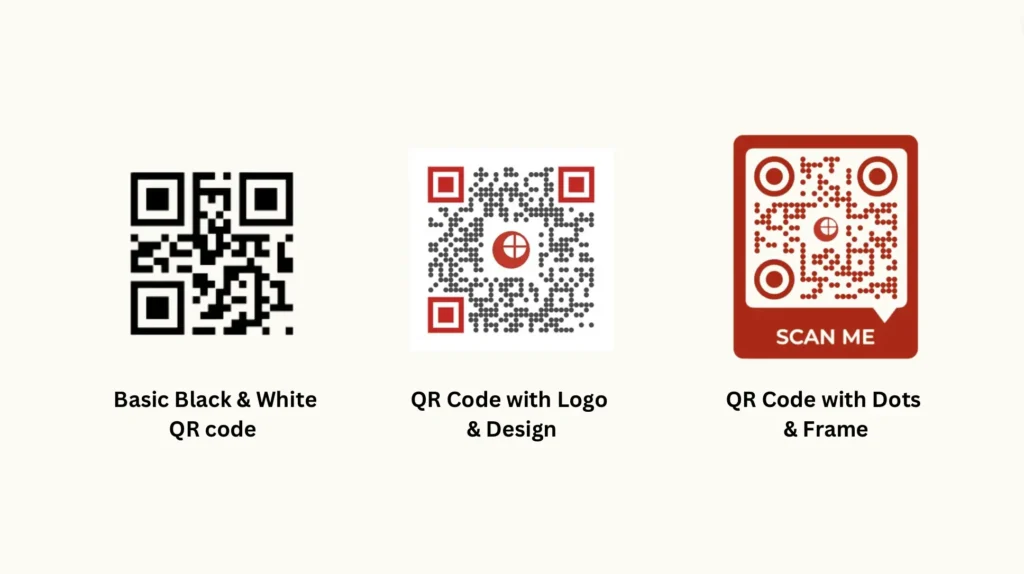
Choosing the right design elements for a personalized touch in your custom QR Codes is crucial.
It helps ensure they are visually appealing, effective, and aligned with your brand or campaign. Here are some key design elements to consider:
1. Color palette
- Contrast: Ensure there is enough contrast between the QR Code and its background for optimal scannability.
- Brand colors: Incorporate your brand’s primary and secondary colors to maintain consistency with your overall visual identity.
- Background color: Choose a background color that complements the QR Code and enhances visibility.
2. Logo or image integration
- Brand logo: Embed your brand logo within the QR Code to reinforce brand recognition.
- Product images: If applicable, include relevant product images or icons to provide context or visual appeal.
3. Custom patterns or backgrounds
- Texture: Introduce subtle patterns or textures to add depth and interest to the QR Code.
- Background design: Create a custom background that aligns with the theme of your marketing campaign or product.
4. Frame or border
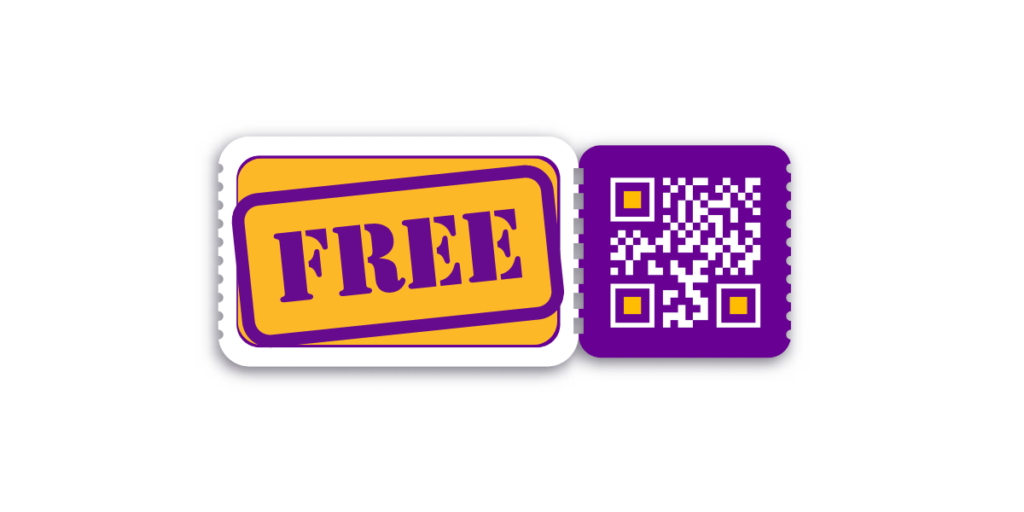
- Frame design: Add a decorative frame or border to frame the QR code and draw attention to it.
- Border color: Choose a border color that complements the overall color scheme.
5. Typography
- Text elements: If applicable, include text elements to provide additional information or context.
- Font style: Use a font style consistent with your brand or campaign. Ensure legibility even at a small size.
6. QR Code shape
Custom shapes: Experiment with non-traditional QR Code shapes, but ensure the core QR Code structure remains intact for scanning functionality.
7. Personalized messages
Greeting or call-to-action: Include a personalized message, greeting, or call-to-action to engage users emotionally.
8. Dynamic elements
Animated features: For digital applications, consider incorporating subtle animations or dynamic elements to capture attention.
9. Size and placement
- Optimal size: Ensure the QR Code is large enough for easy scanning but not so large that it dominates the design.
- Strategic placement: Integrate the QR Code into the overall design in a way that feels cohesive and strategically placed.
Did you know that you can make QR Code white, transparent as well. These QR Codes are often used when the white QR Codes are to be printed later on a contrasting-colored surface, a wristband, for instance.
10. Testing and iteration
- Usability testing: Test the customized QR Code on various devices and scanners to ensure it remains scannable.
- Iterative design: Be open to making adjustments based on user feedback or performance analytics.
E. Creative uses for customized white QR Codes

Beyond basic information encoding, creative applications of QR Codes open up a wide range of possibilities for interactive and engaging experiences.
Here are some innovative ways QR Codes are being used:
1. Interactive print advertising
Embed QR Codes in print advertisements to direct users to dynamic content, such as videos, product demos, or interactive experiences, extending the engagement beyond the printed page.
2. Augmented reality (AR) experiences
Combine QR Codes with AR technology to create immersive experiences.
Users can scan the code to unlock AR content, animations, or virtual elements superimposed on the real world.
3. Art and design installations
Integrate QR Codes into art installations or design projects where scanning the code reveals additional information, artist statements, or multimedia content related to the artwork.
4. Educational materials
Enhance educational materials like textbooks or posters with QR Codes that link to supplementary resources, quizzes, or multimedia content, providing a more interactive learning experience.
5. Interactive Packaging
Incorporate QR Codes on product packaging to offer customers access to additional information, user manuals, product reviews, or even exclusive discounts and promotions.
6. Event invitations and tickets
Create personalized event invitations with QR Codes that, when scanned, reveal event details and RSVP options or provide access to exclusive pre-event content.
7. Scavenger hunts
Organize QR Code-based scavenger hunts where participants scan codes at different locations to receive clues and hints or access the next stage of the game.
8. Menu and recipe integration
Use QR Codes on menus or recipe cards to link customers to videos demonstrating cooking techniques, nutritional information, or the origin of ingredients.
9. Virtual business cards
Instead of traditional business cards, create digital business cards with a QR Code that, when scanned, provides contact information, links to a portfolio, or includes a personalized message.
10. Interactive exhibits in museums
Implement QR Codes in museum exhibits to offer visitors additional insights, historical context, or multimedia content related to the artifacts or artworks on display.
11. Digital graffiti walls
Create digital graffiti walls where users can scan QR Codes to contribute their digital artwork or messages to a collaborative online platform.
12. Travel and tourism guides
Integrate QR Codes into travel brochures, city maps, or guidebooks to provide tourists with instant access to navigation, local insights, or audio guides for key landmarks.
Did you know that Scanova ensures that the data associated with your QR Codes remain safe? Your data is safe with Scanova as it abides by international data privacy and security standards like GDPR, SOC2, and ISO 27001:2022.

E. Common mistakes to avoid when creating a white QR Code

Creating custom white QR Codes can be a visually appealing way to integrate these codes into your branding and marketing materials.
However, creators should avoid several common mistakes to ensure the QR Codes remain functional and visually appealing.
Here are some key mistakes to watch out for:
1. Insufficient contrast
– Mistake: Failing to provide enough contrast between the QR Code and its background can result in scanning issues. If the colors are too similar, scanners may struggle to distinguish the code’s patterns.
– Solution: Ensure there is a clear contrast between the QR Code and its background, even if both are predominantly white. This ensures scanners can read the code accurately.
2. Overly complex designs
– Mistake: Adding too many design elements, intricate patterns, or small details to the QR Code can interfere with its scannability. Complicated designs may confuse scanning devices.
– Solution: Keep the design simple and uncluttered. Focus on key brand elements and ensure the core structure of the QR Code remains intact.
3. Reduced error correction
– Mistake: Lowering the error correction level to make the QR Code look cleaner may compromise its ability to withstand damage or distortion.
– Solution: Maintain a sufficient error correction level to ensure the QR Code remains functional even if it’s slightly damaged or distorted.
4. Inadequate testing
– Mistake: Neglecting to test the custom white QR Code on various devices and with different QR Code scanners can lead to unexpected issues during real-world use.
– Solution: Test the QR Code thoroughly to ensure it can be scanned easily by a variety of devices and applications. Consider testing in different lighting conditions as well.
5. Incorrect size and placement
– Mistake: Placing the QR Code in a location that is too small or too large, or where it competes with other visual elements, can impact both functionality and aesthetics.
– Solution: Ensure the QR Code is appropriately sized for its intended use, and place it strategically within the design. Avoid placing it too close to edges or corners.
6. Using non-compatible colors
– Mistake: Using colors that are not compatible with the scanning capabilities of QR Code readers may result in scanning failures.
– Solution: Stick to colors that provide sufficient contrast and are easily readable by QR Code scanners. Avoid using color combinations that may be challenging for scanners to interpret.
7. Ignoring branding guidelines
– Mistake: Customizing QR Codes without adhering to brand guidelines can lead to inconsistencies in branding and a disjointed visual identity.
– Solution: Ensure that the custom white QR Code aligns with your brand colors, fonts, and overall design principles. Maintain a cohesive visual identity.
8. Neglecting dynamic QR Code capabilities
– Mistake: Forgetting to leverage the dynamic capabilities of QR Codes, such as the ability to update content, can limit the code’s long-term utility.
– Solution: Consider using dynamic QR Codes if you anticipate the need for content updates. This allows you to modify the underlying information without changing the physical appearance of the QR Code.
F. FAQs: Customized white QR Code

Q1: Does a QR Code have to be black and white? Can I customize the color of a QR Code design to be entirely white?
Yes, you can customize the color of a QR Code, including making it entirely white; it doesn’t always have to be basic black and white.
Customization tools often allow you to choose the color of the foreground (the QR Code itself) and the background. Keep in mind that sufficient contrast with the background is essential for proper scanning.
Q2: Are there specific design considerations when creating a white QR Code?
Yes, when creating a white QR Code, ensure there is enough contrast between the code and its background. Use a background color that complements the white QR Code, and avoid overly intricate designs that might interfere with scanning.
Q3: Can I add a logo or image to a white QR Code?
Yes, you can incorporate a logo or image into a white QR Code for branding purposes. However, ensure that the logo doesn’t compromise the clarity of the QR Code, and maintain a good balance between design elements and functionality.
Q4: How do I test the scannability of a white QR Code?
Test the scannability of a white QR Code by using various devices and QR Code scanning apps. Ensure the QR Code remains easily readable in different lighting conditions. Regular testing helps identify and address any issues with scanning.
Q5: Can I use a white QR Code for marketing materials?
Yes, white QR Codes can be effectively used in marketing materials. They allow for brand integration and a clean, modern look. Ensure the QR Code design aligns with your brand colors and enhances the overall aesthetic appeal of your marketing collateral.
Q6: What is the purpose of dynamic white QR Codes?
Dynamic white QR Codes, like dynamic QR Codes in general, allow for content updates without changing the physical appearance of the code. This is useful for scenarios where you might need to modify the linked information over time, such as updating a URL or promotional offer.
Q7: Can I use white QR Codes for product packaging?
Yes, white QR Codes can be used on product packaging to provide consumers with additional information, links to product manuals, reviews, or promotional content. Ensure that the QR code complements the packaging design and maintains scannability.
Q8: What are some common mistakes to avoid when creating white QR Codes?
Common mistakes include insufficient contrast, overly complex designs, reduced error correction, inadequate testing, incorrect size and placement, using incompatible colors, ignoring branding guidelines, and neglecting dynamic QR Code capabilities. Addressing these issues helps create functional and visually appealing white QR Codes.
Q9: Are there specific industries where white QR Codes are more commonly used?
White QR Codes are versatile and can be used in various industries. They are commonly found in retail, marketing, packaging, events, tourism, and educational materials. The key is to align the customization with the goals and aesthetics of the specific industry or use case.
Q10: How do I ensure my custom white QR Codes align with my brand identity?
To ensure alignment with your brand identity, use your brand colors, incorporate logos or brand elements, and adhere to your brand’s design guidelines. Consistency in branding helps create a unified and recognizable visual identity with your custom white QR Codes.


Summing Up
So now you don’t have to wonder: “Can a QR Code be white?” The answer is yes, custom white QR Codes are the most stylish and sleek way of reaching out to your target audience without letting your brand lose its sheen.
They can be easily customized and match perfectly with the design. Whether it’s business cards, event promotion, or product packaging, they will help enhance your brand’s presence and increase the engagement levels.
A custom white QR Code is ideal if you want a QR Code that blends in with your brand but still stands out in the right way. It’s simple, professional, and effective at making a lasting impression.


